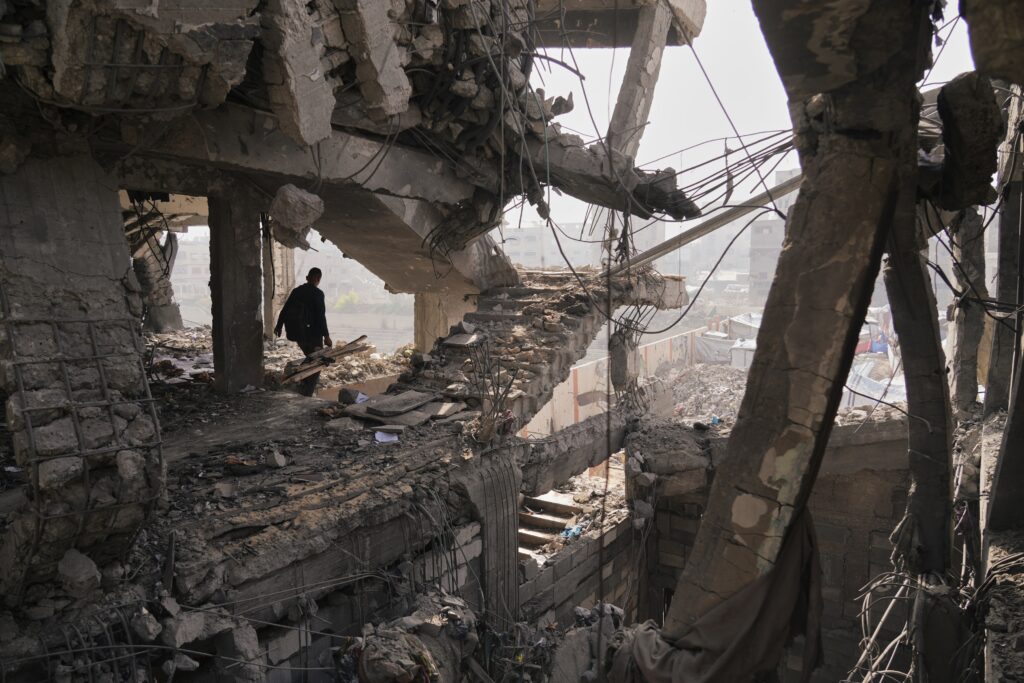A severe shortage of tents and other shelter materials is leaving more than a million Palestinians in Gaza vulnerable to winter weather and disease, with the United Nations and other agencies rushing to repair stormwater infrastructure, as well as thousands of makeshift dwellings damaged or destroyed by recent rains.
For months, Israeli authorities have either blocked or partially restricted the entry of key shelter items, including tents, poles, tools and tarps, despite a U.S.-backed ceasefire that went into effect last month and requires Israel to allow for the unfettered flow of aid.
Israel has said there is no limit to how much humanitarian assistance can enter Gaza — and blames the U.N. for shortages, saying it doesn’t pick up or distribute the items efficiently.
“Over the last few months, in preparation for the winter and protection from the rain, COGAT coordinated with the international community and facilitated close to 140,000 tarpaulins directly to the residents of the Gaza Strip,” the arm of the Israeli Defense Ministry that coordinates aid to Gaza said in a statementthis month. “We are planning a catered humanitarian response for the upcoming winter.”
But Israel has also classified some relief items, including tent poles, as “dual use,” U.N. officials have said, meaning it believes they could be repurposed by militants to make weapons or other equipment. Authorities have also barred some relief groups from bringing in tents, instead approving shelter materials from certain donor states, not all of which are waterproof or durable enough for winter conditions, said Shaina Low of the Norwegian Refugee Council, a humanitarian nonprofit that leads a consortium of organizations focused on shelter needs.
At the same time, the Israeli restrictions — including the continued closure of the Rafah border crossing and suspension of all but two aid corridors inside Gaza — have slowed much-needed repairs to damaged water and sanitation systems, which humanitarian workers warn are in danger of collapsing or overflowing when there is another storm.
A recent downpour sent a deluge of water, some of it contaminated, coursing through the streets and into camps, tents and partially destroyed homes, affecting more than 740,000 people, according to the U.N. Office for the Coordination of Humanitarian Affairs (OCHA), which said the floodwaters “destroyed what little shelter and belongings thousands of Palestinians in Gaza had left.”
“Children in Gaza are sleeping on the bare ground with no shelter, in flimsy shorts and t-shirts that are sodden with sewage water after their tents flooded in a weekend of heavy rains, putting them at risk of disease,” Save the Children, a global charity, said in a statement.
Together, the inclement weather and exposure to hazardous waste could trigger more widespread suffering and public health crises in Gaza, according to the World Health Organization, even as Palestinians try to restore some semblance of normalcy after two years of war.
This winter’s forecast includes above-average rainfall for Gaza, as well as strong winds and coastal surges in “an environment where sewage ponds are already overflowing, half a million tons of waste lie uncollected … and fragile tents are pitched on bare, flood-prone ground,” the WHO wrote in a 39-page public health report published this month, citing climate analysis and weather predictions from the risk intelligence firm SARI Global.
Yareen Abu al-Naja, 44, already knows what suffering the storms might bring. Earlier this month, when up to three inches of rain fell on Gaza over a short period, she said the many holes in her already dilapidated tent “felt like daggers in my heart.”
Dirty water swept into part of her shelter in Mawasi in southern Gaza, a crowded strip of sandy coastline the Israeli military once designated a “safe zone” during the war. Abu al-Naja spent the night of Nov. 13 holding a plastic bucket over the heads of her mother and young son, she said.
“The war ended, yet our wounds haven’t,” she said in a WhatsApp message. “A new war began, a psychological war of oppression and humiliation.”
Israel halted much of its military activity in Gaza when the ceasefire started on Oct. 10, but its forces still control more than half of the enclave. Since then, Israeli strikes, shelling and gunfire have killed more than 300 Palestinians, according to the Gaza Health Ministry.
Few people there say their lives have materially improved.
More food is now entering the territory, after the world’s leading authority on hunger confirmed famine in Gaza City in August. But dietary diversity remains low, with access to vegetables, fruits and protein still out of reach for many families, according to the World Food Program.
At the crossings, Israeli authorities are de-prioritizing U.N. and other humanitarian cargo in favor of commercial imports, which “often consist of high-cost, low-nutritional-value goods, such as soft drinks and chocolate,” OCHA said, citing WFP.
On Saturday, the U.N. said, Israeli forces denied all three of its missions to collect tents, food and other supplies from the Kerem Shalom crossing in southern Gaza. And according to a U.N. dashboard that tracks the aid it coordinates and delivers with partners in Gaza, shelter items have made up about 8 percent of the weight of all U.N.-backed assistance that has entered the territory since Oct. 10.
“A lot of things still remain the same since the ceasefire,” said a U.N. staff member familiar with the aid restrictions, who spoke on the condition of anonymity because they were not authorized to discuss them with the media. “We’re still having issues bringing in shelter assistance … because of these bureaucratic and administrative bottlenecks.”
In the meantime, the majority of Gaza’s population is confined to areas with extreme exposure to climate hazards and no functioning infrastructure, leading to the proliferation of communicable diseases and respiratory illnesses among malnourished residents who are particularly vulnerable to infections, according to the WHO.
In Mawasi, Abu al-Naja says that her son Ahmed, 9, splits his day between waiting in long lines for food and water and studying in a dusty, makeshift classroom with 60 other students. She worries constantly that he will fall sick.
This month, the U.N. and Gaza Health Ministry rolled out the first round of a “catch-up” immunization program for children who missed or fell behind on routine vaccinations because of the war. They began by inoculating more than 13,000 children against diseases such as measles, mumps, tetanus, pertussis, polio, rotavirus and pneumonia, among others.
Health workers also screened about half of the patients for malnutrition: Of 6,827 children screened, 508 were found to be acutely malnourished, the U.N. Children’s Fund said in a statement. The U.N. also said this month that 9,200 new cases of acute malnutrition were reported among the 110,000 children screened in October, down slightly from 11,700 cases in September and 14,400 in August.
Mohsen Radi, 35, said his 2-year-old son Mohammed was one of the children vaccinated in the drive. Radi lives with his wife and three children, including Mohammed, in a tent in the Rimal neighborhood of Gaza City. The shelter buckled under the recent rain, he said, and everything inside the tent, including blankets, pillows, clothes and kitchen items, was underwater.
The last time he received food aid was when WFP gave the family a food parcel last month. Radi doesn’t know if their house, located on the Israeli-controlled side of Gaza, is still standing. For now, he said, the family relies each day on one meal of thin lentil soup to stay warm.
About 15 miles south in Khan Younis, 48-year-old Baha Shurrab was angry about Gaza’s bleak future after another sleepless night in the cold. Shurrab says he lives in a structure made of tarp, a cement wall and thin rugs to cover the sandy floor. Insects and garbage are everywhere, he said.
The weather in Gaza is still mild during the day but at night, temperatures drop and the cold rouses Shurrab from his sleep. He doesn’t have any winter clothes and is not sure how he will get any. Instead, he wakes up each morning to pray and search for scraps of paper and plastic to light a fire on his small stove.
For now, Shurrab is surviving on handouts of lentils, which he calls his “most loyal friend” because of how reliably available they are, as well as canned food he described as “unfit for humans” to eat.
“Nothing remains to cry over,” he said.
Siham Shamalakh contributed to this report.
The post Lack of tents, food and warm clothes leaves Gazans exposed ahead of winter appeared first on Washington Post.




